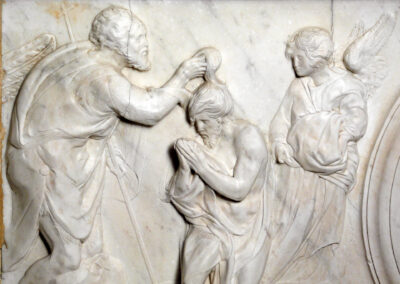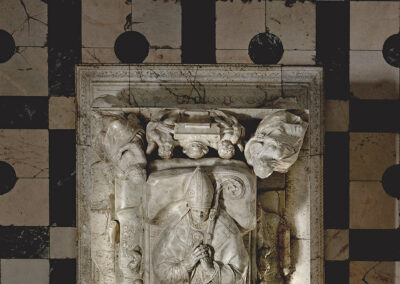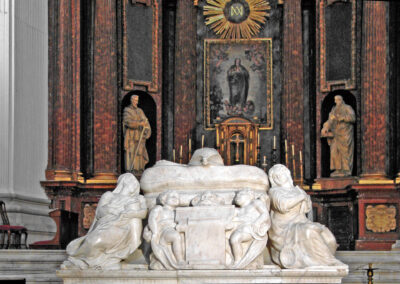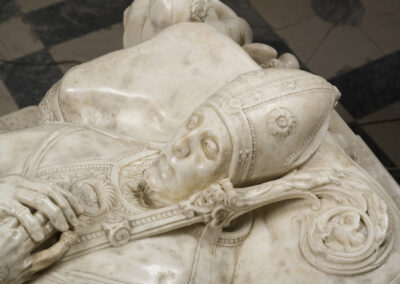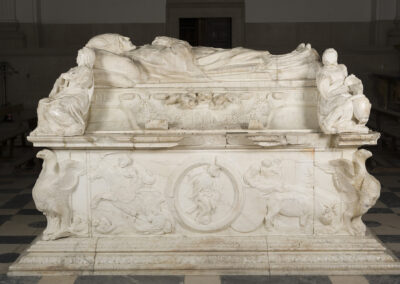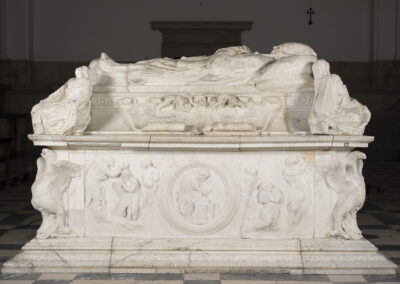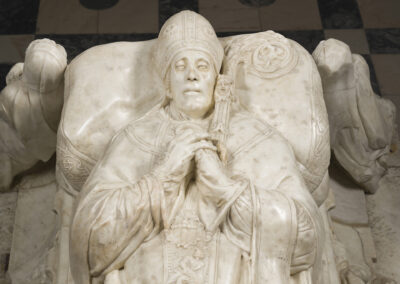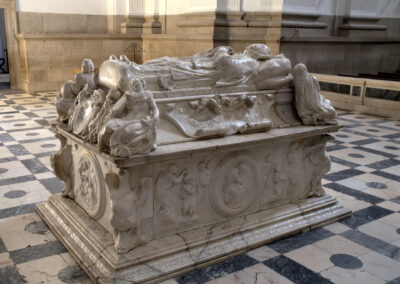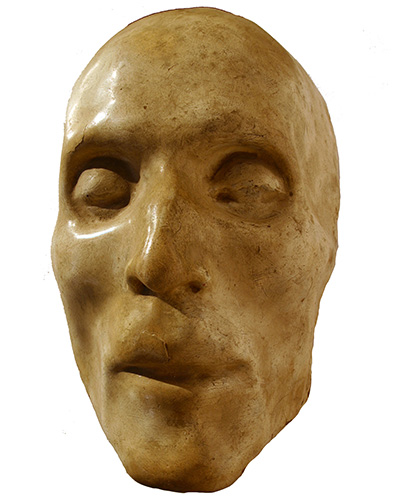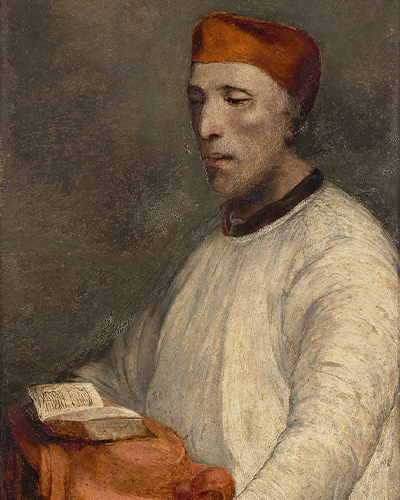Although Diego Tavera, nephew and testamentary of the Cardinal and future bishop of Jaén, did not sign the contract commissioning this sepulchre until 20 August 1554, it is documented that the ".statuary and imaginary"Berruguete, as Alonso Berruguete is called, had been working on it since April 1552, six months before the prelate's body was transferred to Toledo.
From the appraisers of the sepulchre, we know that the aforementioned contract -unfound to date- set a price of 3000 ducats for the work and obliged the sculptor to take as a model the sepulchre that Bartolomé Ordoñez had carved for Cardinal Cisneros in 1524. The price agreed was the highest ever stipulated for a sepulchre and 900 ducats more expensive than that paid for the one to be taken as a model, an indicator of the prestige enjoyed by Berruguete in the mid-16th century (M. J. Redondo Cantera, 1987, p. 39). He also informs us of the requirement to sculpt it in Carrara marble, an obligation which, in 1558, by contract with the sculptor and merchant Juan de Lugano, was qualified by adding that it had to come from the quarry of Polvaccio, the same quarry from which Michelangelo sourced his supplies, a requirement in which Manuel Arias sees a final tribute from Berruguete "...".to his most revered teacher".
This same valuation document, provided by Fernando Marías (2007), refutes the traditional assumption that the sculptor's death in hospital prevented him from completing it. Shortly before "the wise artist who brought the light of Italy to our landOn 13 September 1561, Nicolás de Vergara the Elder and the painter Francisco de Comontes - appraisers appointed by the hospital and the sculptor respectively - certified, after a thorough analysis of each of the elements, a process that lasted twelve days, that Berruguete had conformed to Cardinal Cisneros' sepulchral model, "...and that the sculptor, who was to die in a room under the clock tower, was the one who, after the death of his father, was the one who was to die".with very great improvement"in many of its parts.
Despite the forced footing implied by the obligatory reference to the tomb of Cisneros, those who have studied it best, Manuel Arias and Fernando Marías, agree in pointing out that in this work Berruguete breaks radically with the codified way of presenting narrative scenes in this type of monument, since, on the four sides, the sculptor dispenses with the frames of niches and columns, so that the "...the scenes are presented in the same way as in the tomb of Cisneros", and the "narrative scenes are presented in the same way as in the tomb of Cisneros", as in the "tomb of Cisneros".figures sprout from the stone support"In the words of the former, "almost in the same way that the shapes of Michelangelo's figures emerged"in those of the second.
The iconographic programme opens with the theme of the imposition of the chasuble on Saint Ildefonso, a clear allusion to his status as successor in the primate mitre of this patron saint of Toledo, father of the Church, and closes, or opens, in the eyes of the faithful who come to the chapel, with the image in tondo of the virtue of Charity, the most important of the theological virtues for someone who dedicated the last years of his life to the political and doctrinal problem of poverty, a concern that led him to found the welfare institution in which he was finally buried. The side of the Gospel is dedicated to the titular figure of the church, Saint John the Baptist - as proclaimed by the symbols of his martyrdom that adorn the metopes of the entablature, the cutlass that decapitated him, and the paternoster on which his head was presented to Salome - whose life is summed up in two scenes, the Baptism of Christ and his beheading, flanking a tondo with his figure pointing to a lamb, a quotation from the Gospel passage in which the Baptist says "...".Behold the Lamb of God who takes away the sin of the world."(John 1:29). The other side, with an identical compositional structure, is dedicated to the apostle St. James - a reference to the episcopal see that the cardinal had occupied before that of Toledo - with the scenes of the battle of Clavijo and the transfer of his remains to Compostela, which surround the tondo with the effigy of St. James the Pilgrim. As in that of Cisneros, the side angles are occupied by four eagles which, in this case, could symbolise the cardinal's title of the deceased, San Juan ante portam Latinam.
The recumbent figure stands out for the quality and preciousness of the reliefs of the crozier, cushion and pluvial cloak, which contrast with the absence of any idealisation in a face that conveys all the pathos of death, as reflected in the death mask that the sculptor had removed from the corpse and which is still preserved in the Hospital's sacristy. In the four corners, the forced postures of the four cardinal virtues are in keeping with Berruguete's style, while the hairstyles and the folds of the clothing evoke the Raphael of the Stanza della Segnatura. The centres of each of the sides are topped by figures of putti, whose disconsolation, on the long sides, forces them into impossible foreshortenings, and, on the short sides, they hold either the cardinal's coat of arms or a cartouche which, on Berruguete's death, was left without its inscription.


